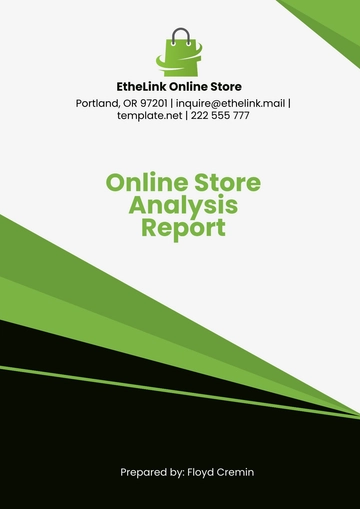Free Business Opportunity Analysis

I. Executive Summary
This analysis explores a new business opportunity for [YOUR COMPANY NAME] in the technology sector, specifically focusing on the development and marketing of a revolutionary smart home device. The market demand, competition, customer preferences, and potential profitability have been thoroughly researched in this report.
II. Market Analysis
Understanding the market is crucial to evaluating the potential of this new business opportunity. The current market trends, size, and projected growth are discussed in this section.
A. Market Size and Growth
Year | Market Size (in billion USD) | Growth Rate (%) |
|---|---|---|
2061 | 50 | 8 |
2062 | 54 | 8 |
2063 | 58 | 7 |
2064 | 62 | 7 |
B. Key Market Trends
The following key trends have been identified in the smart home device market:
Increased integration with AI and machine learning.
Rising consumer demand for energy-efficient solutions.
Growing adoption of home automation systems.
Enhanced focus on cybersecurity for smart devices.
Expansion of the Internet of Things (IoT) ecosystem.
III. Competitive Analysis
This section evaluates the competitive landscape to understand the strengths and weaknesses of existing players, as well as potential barriers to entry.
A. Competitors Overview
Company | Market Share (%) | Main Product | Strengths | Weaknesses |
|---|---|---|---|---|
Innovo Corp | 25 | Smart Thermostat | Strong brand recognition, advanced technology | High price point, limited customer support |
Trendy Tech | 20 | Smart Security System | Wide range of products, robust security features | Complex installation process, less user-friendly |
Smart Machines | 15 | Smart Lighting | Cost-effective, easy to use | Limited product compatibility, lower durability |
B. Barriers to Entry
The major barriers to entry in the smart home device market include:
High initial capital investment for research and development.
Strong presence of established brands.
Rapid technological advancements require continuous innovation.
Stringent regulatory standards related to data privacy and security.
IV. Customer Analysis
In this section, we delve into the potential customer base, their preferences, and purchasing behaviors.
A. Target Customer Segments
The primary target customer segments for smart home devices are:
Tech Enthusiasts: Individuals who are early adopters of new technology and gadgets.
Homeowners: People looking to enhance the security and efficiency of their homes.
Eco-conscious Consumers: Customers seeking to reduce their environmental footprint with energy-efficient solutions.
Parents: Families interested in the safety and monitoring features of smart home devices.
B. Customer Preferences
Based on market research, the following preferences have been identified among the target customer segments:
Reliability and durability of devices.
Ease of installation and use.
Compatibility with other smart home systems and devices.
Affordable pricing and value for money.
Strong customer support and service.
C. Purchasing Behavior
Understanding purchasing behavior is critical to tailoring marketing strategies. Key insights include:
The majority of purchases are influenced by online reviews and ratings.
Customers often compare multiple brands before making a decision.
Promotional offers and discounts significantly impact purchase decisions.
Subscription-based models for software updates are gaining popularity.
V. Financial Analysis
A detailed financial analysis is essential to determine the viability of the business opportunity. This section outlines the projected revenue, costs, and profitability.
A. Projected Revenue
Year | Units Sold | Revenue (in million USD) |
|---|---|---|
2063 | 200,000 | 40 |
2064 | 350,000 | 70 |
2065 | 500,000 | 100 |
2066 | 650,000 | 130 |
B. Cost Analysis
The cost structure primarily includes production, marketing, and operational expenses. An estimated breakdown is as follows:
Cost Component | Annual Expense (in million USD) |
|---|---|
Production Costs | 30 |
Marketing Costs | 15 |
Operational Costs | 10 |
Research and Development | 20 |
C. Profitability Analysis
Based on the projected revenue and cost estimates, the net profit is calculated as follows:
Year | Revenue (in million USD) | Total Costs (in million USD) | Net Profit (in million USD) |
|---|---|---|---|
2063 | 40 | 75 | -35 |
2064 | 70 | 75 | -5 |
2065 | 100 | 75 | 25 |
2066 | 130 | 75 | 55 |
VI. Strategic Recommendations
Based on the analysis, the following strategic recommendations are put forth to enhance the success of the business venture.
A. Product Development
Focusing on innovative product features and usability can set the product apart from competitors. Key actions include:
Investing in cutting-edge AI and IoT technologies.
Ensuring seamless integration with existing smart home ecosystems.
Prioritizing user-friendly interfaces and installation guides.
B. Marketing Strategy
A robust marketing strategy is essential to capture market share. Recommended approaches are:
Leveraging digital marketing channels including social media, SEO, and influencer partnerships.
Offering promotions and discounts, especially during product launches.
Building a strong online presence through a user-friendly website and engaging content.
C. Customer Support
Providing excellent customer support can significantly enhance customer satisfaction and loyalty. This includes:
Establishing a dedicated customer support team accessible via multiple channels (phone, email, live chat).
Creating detailed FAQs, user manuals, and tutorial videos.
Implementing a responsive feedback mechanism to continuously improve product and service quality.
VII. Conclusion
The smart home device market presents a promising business opportunity with substantial potential for growth and profitability. By focusing on innovative product development, strategic marketing, and robust customer support, [YOUR COMPANY NAME] can effectively navigate the competitive landscape and achieve long-term success. Ongoing market analysis and adaptation to evolving customer needs will be critical to maintaining a competitive edge.
- 100% Customizable, free editor
- Access 1 Million+ Templates, photo’s & graphics
- Download or share as a template
- Click and replace photos, graphics, text, backgrounds
- Resize, crop, AI write & more
- Access advanced editor
Seize new ventures with confidence using Template.net’s editable Business Opportunity Analysis Template. This customizable template is perfect for evaluating potential business opportunities, providing a clear framework that can be tailored and edited in our Ai Editor Tool. Ensure your analysis is precise and aligned with your strategic goals for maximum business growth.





























